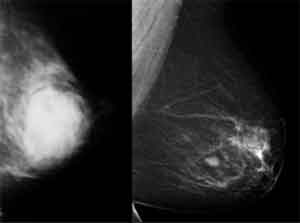- Home
- Editorial
- News
- Practice Guidelines
- Anesthesiology Guidelines
- Cancer Guidelines
- Cardiac Sciences Guidelines
- Critical Care Guidelines
- Dentistry Guidelines
- Dermatology Guidelines
- Diabetes and Endo Guidelines
- Diagnostics Guidelines
- ENT Guidelines
- Featured Practice Guidelines
- Gastroenterology Guidelines
- Geriatrics Guidelines
- Medicine Guidelines
- Nephrology Guidelines
- Neurosciences Guidelines
- Obs and Gynae Guidelines
- Ophthalmology Guidelines
- Orthopaedics Guidelines
- Paediatrics Guidelines
- Psychiatry Guidelines
- Pulmonology Guidelines
- Radiology Guidelines
- Surgery Guidelines
- Urology Guidelines
Mammography useful in males also- may help predict cancer in high risk population

Breast cancer is often considered a disease that occurs only in females. But, men may get breast cancer too. In a cohort study, screening mammography yielded a cancer detection rate of 4.9 cancers/1000 examinations in males which is similar to the detection rate of screening mammography in a population of women at average risk, suggesting that screening mammography is beneficial in male patients at high risk for breast cancer. The findings appeared in the Journal of Breast cancer research and treatment.
Since males are also not spared from the risk of developing breast cancer, the present study was designed to investigate the utility of mammography for breast cancer screening in a population of males at increased risk for breast cancer.
In this HIPAA-compliant institutional review board-approved single-institution study, mammography records and clinical data of 827 male patients who underwent digital mammography from September 2011–July 2018 were analyzed via the electronic medical record. 664 of these men presented with masses, pain, or nipple discharge and were excluded from this study. The remaining 163 asymptomatic men with familial and/or personal history of breast cancer, or with a known germline mutation in BRCA, underwent screening mammography and were included in this analysis.
Key findings
- 163 asymptomatic men underwent 806 screening mammograms.
- 125/163 had a personal history of breast cancer and 72/163 had a family history of breast cancer.
- 24/163 were known as mutation carriers: 4/24 BRCA1and 20/24 BRCA2. 792/806 of the screening mammograms were negative 10/806 were classified as BI-RADS 3, all of which were eventually downgraded to BI-RADS 2 on follow-up.
- 4/806 mammograms were abnormal (BI-RADS 4/5): all were malignant. The cancer detection rate in this cohort was 4.9 cancers/1000 examinations.
To conclude the study the authors wrote: "In our cohort, screening mammography yielded a cancer detection rate of 4.9 cancers/1000 examinations which is like the detection rate of screening mammography in a population of women at average risk, indicating that screening mammography is of value in male patients at high risk for breast cancer."
For further reference, please click on the link
https://link.springer.com/article/10.1007/s10549-019-05338-1

Disclaimer: This site is primarily intended for healthcare professionals. Any content/information on this website does not replace the advice of medical and/or health professionals and should not be construed as medical/diagnostic advice/endorsement or prescription. Use of this site is subject to our terms of use, privacy policy, advertisement policy. © 2020 Minerva Medical Treatment Pvt Ltd